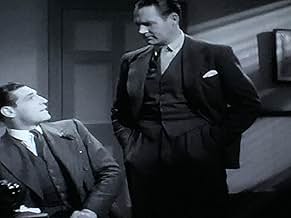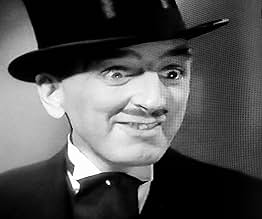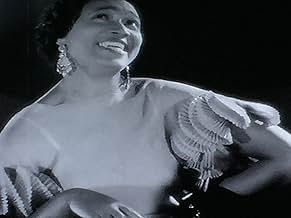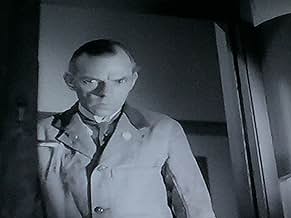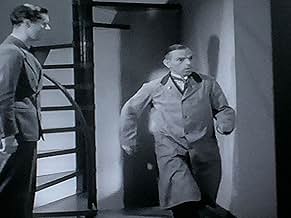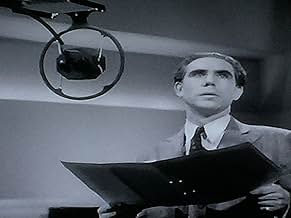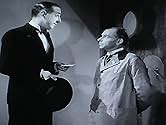When an actor is murdered at the BBC Inspector Gregory finds he has many suspects to choose from.When an actor is murdered at the BBC Inspector Gregory finds he has many suspects to choose from.When an actor is murdered at the BBC Inspector Gregory finds he has many suspects to choose from.
- Director
- Writers
- Stars
Lilian Oldland
- Joan Dryden
- (as Mary Newland)
Betty Ann Davies
- Poppy Levine
- (as Betty Davies)
Gershom Parkington
- Gershom Parkington - Musician
- (as Gershom Parkington Quintette)
- Director
- Writers
- All cast & crew
- Production, box office & more at IMDbPro
Featured reviews
Well, he did, and he was a writer and actor.
Val Gielgud appears in "Death at Broadcasting House" along with Ian Hunter, Austin Trevor, and Lilian Oldland.
When a radio actor is strangled on a live broadcast, a detective (Ian Hunter) comes to investigate. He finds adultery, previous history between some of the cast.
It's an interesting mystery, but it's not the star. The star is the wonderful art deco sets, and singing by both Elizabeth Welch and Eve Becke, and a dance number.
It's a short film, but enjoyable.
Val Gielgud appears in "Death at Broadcasting House" along with Ian Hunter, Austin Trevor, and Lilian Oldland.
When a radio actor is strangled on a live broadcast, a detective (Ian Hunter) comes to investigate. He finds adultery, previous history between some of the cast.
It's an interesting mystery, but it's not the star. The star is the wonderful art deco sets, and singing by both Elizabeth Welch and Eve Becke, and a dance number.
It's a short film, but enjoyable.
This is pretty fascinating stuff on a number of levels: the then visualisation of radio broadcasting for cinema audiences, the then limitations of radio and cinema technology, a frank and snappy dialogue, some wonderful art deco furniture and sets, the great Elizabeth Welch singing, and an all too brief song from Eve Becke and whichever band Percival Mackay was leading at the time. And the BBC for once apparently received no complaints after twenty five million people had listened to a live radio strangulation. Probably Lord Reith would have at least apologised.
A radio actor is murdered during a live broadcast, the cast and crew are therefore suspect – and the hunt by Detective Inspector Ian Hunter is soon on for the culprit in a short and swift film. The perceived interiors of Broadcasting House looked flimsier than the acting but the unmasking of the dastard involved a cast-iron alibi being broken. It's one thing knowing that back then BBC radio newsreaders were booted and suited or in full evening gowns with no one to see them but another to have scantily-clad showgirls performing mainly for the edification of the microphones. Maybe it's a BBC trait! There's a young heavily eye-shadowed Jack Hawkins in here, Henry Kendall was as urbane as ever, and Donald Wolfit had a small - but vital - part in one of his first films. Many iconic poses were struck with many nice scenes. What a pity all BBC broadcasts weren't preserved on steel tape, never mind about for the Empire but for the broadcastless future generations - over the years many BBC radio shows survived only on transcription discs meant for foreign consumption.
If I wanted to be awkward I could add that I personally think genuine talent and honest morality have both been strangled to death at the obese Broadcasting House over the last eighty years too and because of this no one has therefore logically seen fit to make a movie about it. But I'm glad this was made - it's still a refreshing atmospheric whodunit and something to make you think!
A radio actor is murdered during a live broadcast, the cast and crew are therefore suspect – and the hunt by Detective Inspector Ian Hunter is soon on for the culprit in a short and swift film. The perceived interiors of Broadcasting House looked flimsier than the acting but the unmasking of the dastard involved a cast-iron alibi being broken. It's one thing knowing that back then BBC radio newsreaders were booted and suited or in full evening gowns with no one to see them but another to have scantily-clad showgirls performing mainly for the edification of the microphones. Maybe it's a BBC trait! There's a young heavily eye-shadowed Jack Hawkins in here, Henry Kendall was as urbane as ever, and Donald Wolfit had a small - but vital - part in one of his first films. Many iconic poses were struck with many nice scenes. What a pity all BBC broadcasts weren't preserved on steel tape, never mind about for the Empire but for the broadcastless future generations - over the years many BBC radio shows survived only on transcription discs meant for foreign consumption.
If I wanted to be awkward I could add that I personally think genuine talent and honest morality have both been strangled to death at the obese Broadcasting House over the last eighty years too and because of this no one has therefore logically seen fit to make a movie about it. But I'm glad this was made - it's still a refreshing atmospheric whodunit and something to make you think!
The querulous, and frequently catty cast of a lurid radio play distressingly find them crime, as one of them is murdered by malevolent persons unknown! Sleekly suave Det. Inspector Gregory (Ian Hunter) is called upon to investigate the dastardly strangler in this splendidly entertaining 1930s whodunnit, greatly enlivened by a remarkably droll text, and many colourfully theatrical performances from an amusingly stiff upper-lipped cast of erudite British Thespians, including a very young Jack Hawkins. 'Death at Broadcasting House is ripping good yarn, energetically told by a fine ensemble cast of actors. 'Murder Immaculate indeed!' This consistently engaging thriller works splendidly as escapist entertainment, and is doubly fascinating as a delightfully vivid document of the frightfully middle-class milieu of Broadcasting House in the 1930s, it's truly wonderful that such beautifully made films are still available for future generations of film fans to enjoy.
I always give early-1930s movies the benefit of the doubt, and I'm doing so here. An actor working alone in a radio studio room is murdered while reading his lines (in which his character is murdered). Someone in the studio building at the time killed him, but whom? There are only a few possible culprits, and most aren't very well defined characters. A few years later, this probably could have been a very good movie, but it's barely passable here. I suspect much of the appeal of this film when it was released came from the behind-the-scenes look at a working radio studio, with actors in multiple rooms, and orchestra in another, and crew in still others. You even get a song and a dance number, although the appeal of a dance number on radio, including dancers in full costume, escapes me.
If you enjoy 1930s crime/mysteries, then this is worth a watch. The detective doesn't define himself particularly well, but the genre plays out reasonably true to form. I gave it a 6 for slightly better than average.
If you enjoy 1930s crime/mysteries, then this is worth a watch. The detective doesn't define himself particularly well, but the genre plays out reasonably true to form. I gave it a 6 for slightly better than average.
While dozens of people go about their jobs of getting news and entertainment out on the BBC -- including a chorus of dancers in elaborate costumes -- a minor actor is being rehearsed for a role in an original crime drama. His screams as he is strangled -- in the role -- are not satisfactory. However, during the performance, he gives a much better performance. That's because he is strangled and his corpse left by the microphone.
It's a production with a fancy background, and a cast that includes several well-known broadcasters and performers of the era. Ian Hunter is the Scotland Yard inspector who investigates -- in contrast to American movies, in which it's a private citizen or detective, or a government investigator with a chip on his shoulder who solves the case, in Britain in this era, it was someone more official and with less personality quirks. Among the suspects are Austin Trevor, Val Gielgud (who wrote the book this movie is based on) and Jack Hawkins.
It's directed for efficiency by Reginald Denham, and the cinematographer is Gunther Krampf. Although he is best remembered for his impressionist work for Pabst, he lights the Art Moderne sets here brightly and flatly. Still, although the mystery is well done and the method used to identify the murderer sound good, I thought there was little of humanity or interesting characters in the movie.
It's a production with a fancy background, and a cast that includes several well-known broadcasters and performers of the era. Ian Hunter is the Scotland Yard inspector who investigates -- in contrast to American movies, in which it's a private citizen or detective, or a government investigator with a chip on his shoulder who solves the case, in Britain in this era, it was someone more official and with less personality quirks. Among the suspects are Austin Trevor, Val Gielgud (who wrote the book this movie is based on) and Jack Hawkins.
It's directed for efficiency by Reginald Denham, and the cinematographer is Gunther Krampf. Although he is best remembered for his impressionist work for Pabst, he lights the Art Moderne sets here brightly and flatly. Still, although the mystery is well done and the method used to identify the murderer sound good, I thought there was little of humanity or interesting characters in the movie.
Did you know
- TriviaThis film received its earliest documented USA telecasts in Los Angeles Sunday 16 October 1949 on KFI (Channel 9) and in New York City Saturday 11 February 1950 on WPIX (Channel 11).
- Quotes
Rodney Fleming: [to the lift-man] I'm looking for Variety.
lift-man: That's eight floors down.
Rodney Fleming: But I've just come eight floors up!
lift-man: Then it'll be sixteen floors down.
- ConnectionsReferenced in Those British Faces: A Tribute to Jack Hawkins 1910-1973 (1993)
Details
- Release date
- Country of origin
- Language
- Also known as
- Death at a Broadcast
- Filming locations
- A.S.P.I. Studios, Wembley Park, Middlesex, England, UK(studio: produced at A · S · P · I Studios Wembley Park)
- Production company
- See more company credits at IMDbPro
- Runtime
- 1h 15m(75 min)
- Color
- Aspect ratio
- 1.37 : 1
Contribute to this page
Suggest an edit or add missing content

